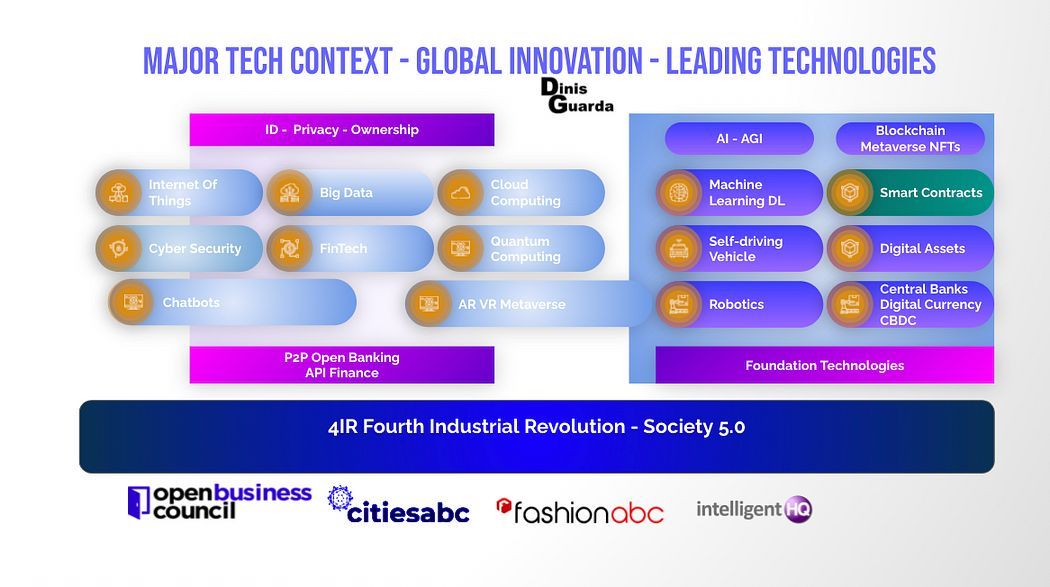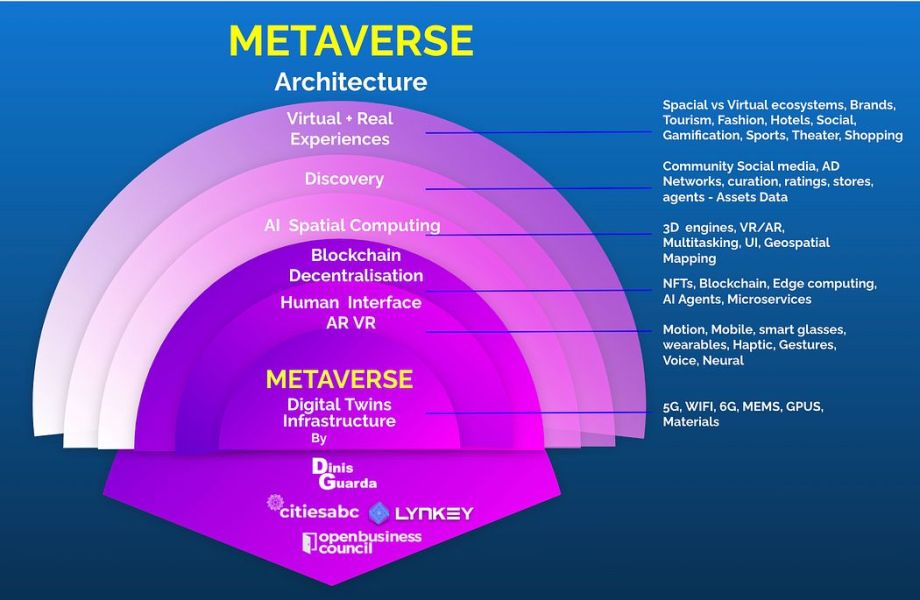Meta + Verse
Metaverse is composed of two words: Meta + Verse.

To better understand the complex topic of the metaverse, it is worth looking at the etymological origin of the ancient Greek word “meta”. Its original meaning is “beyond,” transcending, “after,” or “behind”.
Metaphysics, Metacognition are some words that use the prefix “Meta”. Metacognition, for example, means to have an awareness and understanding of one’s own thought processes. The “transcending” sense of meta has a powerful and even poetic sense in our society and our human tribal operating systems. The metaverse is then a digital counterpart to the physical world in which we live.
The more powerful example of the Metaverse was the online social space Second Life. Created in 2003, Second Life is a multimedia platform that allows people to create an avatar for themselves and have a second life in an online virtual world.
With 18-year-old history as a virtual world Second Life had everybody talking about it being probably the first scaled metaverse long before we entered this modern second iteration of Metaverse epoch. Linden Lab, the publisher and creator of Second Life (the virtual world that debuted way back in 2003) is still going strong with over 10 million active users as stated by Ebbe Altberg, the current CEO of Linden Lab in an interview with VICE News.
The platform was and is a global powerhouse that principally features virtual 3D-based user-generated content. Second Life also has its own virtual currency, the Linden Dollar, which is exchangeable with real world currency. Since 1999, when Philip Rosedale formed the Linden Lab for developing computer hardware to allow people to become immersed in a virtual world. That vision changed into the software application Linden World, in which people participated in task-based games and socialising in a three-dimensional online environment. Philip Rosedale was familiar with the Metaverse of Neal Stephenson’s novel Snow Crash, Rosedale has said that his vision of virtual worlds predates that book
The modern concept of Metaverse that now is trending as the next big thing first surfaced thirty years ago with author Neal Stephenson’s iconoclastic science fiction novel Snow Crash, in which humans gather and interact in a massive multiplayer virtual world.
The Metaverse concept can then be simply defined as a digital twin of our world in which we live, operate, communicate, learn, research, play, entertain, buy and sell things.
In a world fast moving within the context of the 4Th Industrial Revolution or Society 5.0 we have a Major Tech Context — Global Innovation — leading technologies that include ID — Privacy and Ownership shift with AI — Augmented Intelligence touching all of our human social economic interactions. This while Fintech, cybersecurity with the emergence and growth of Blockchain and the 360 concept of Metaverse powered with NFTs becoming our foundation certification technological systems.
My below infographic tries to reflect this:

During the pandemic, and in the aftermath of it when all of us have drawn to exist and interact with each other on a global online world. Those months of lockdown also accelerated the digital transformation we had seen rise at a slower pace, in the previous decades. In a few months, we were all living in a digital world, and interacting naturally on global digital platforms. Blockchain projects flourished, Online summits and collaborations were created at a global scale, video streaming softwares, like Zoom, transformed our entertainment and communication enabling dialogue, collaboration and creativity, as never seen before… over a screen.
The Metaverse is now the sum of our digitisation and the mainstream creation of digital twins of everything in our cities and lives. As a result of an exponential digitisation of all kinds of systems and structures, from gaming to fashion, property, health, to education, to finance, to property assets the Metaverse economy will become part of the real economy.
The Metaverse is helping the management of our tribal communities, the creation and scale of the physical and virtual what we call the digital twins (the digital replica) of just about everything around us: from our entertainment, playtimes, art, to our health to our assets. So far we have not found a way to certify and monetize our digital world as we did with paper technology but with NFTs that might be looming on the horizon we found a way to scale our organic carbon footprint and our virtual dreams visualisation of reality — realities!
This Metaverse Digital Twins Infrastructure Architecture infographic explains the possibilities and challenges we are facing:

“The metaverse will be the real world in the near future” ― Anuj Jasani
“Augmented reality is the ‘boy who cried wolf’ of the post-Internet world — it’s long been promised but has rarely been delivered in a satisfying way.” — Om Malik
“A key part of that journey is making an open platform where any developer can create anything they want.” — Mark Zuckerberg
“I do think that a significant portion of the population of developed countries, and eventually all countries, will have AR experiences every day, almost like eating three meals a day. It will become that much a part of you.” — Tim Cook
Also my video about NFT Art — Blockchain Digital Collectives — Non-Fungible Tokens Research Film by Dinis Guarda gives a context of the scale of the Metaverse that it is in its inception as we speak but already reaching a combined economy ecosystem of $1.5 Trillion.
How can you imagine your day-to-day Metaverse(s) possibilities?
Our days are now digitally enabled. We are increasing shifting between digital and offline. We are using wearables, Augmented reality AR, virtual assistant robots, our smartphones, and glasses are giving us the capacity to do more than overlay directions and show us digital calendars.
Metaverse is a blurred amplification of our real world and as the AR glasses, AR, VR are the portal to the next wave of computing — spatial computing. It’s where digital avatars, digital representations of ourselves, and the physical world intermingle to form a new reality. It’s already happening with mixed reality and spatial computing headsets, social media AR filters and lenses, and Google Maps Live View. One thing the pandemic has shown us is that our lives are becoming more digitised and virtualised.
These solutions are becoming our new evolution as humans as they revolutionise the way we dream, practice our wellbeing, play, work, socialise, and take care of ourselves.

Dinis Guarda is an author, academic, influencer, serial entrepreneur, and leader in 4IR, AI, Fintech, digital transformation, and Blockchain. Dinis has created various companies such as Ztudium tech platform; founder of global digital platform directory openbusinesscouncil.org; digital transformation platform to empower, guide and index cities citiesabc.com and fashion technology platform fashionabc.org. He is also the publisher of intelligenthq.com, hedgethink.com and tradersdna.com. He has been working with the likes of UN / UNITAR, UNESCO, European Space Agency, Davos WEF, Philips, Saxo Bank, Mastercard, Barclays, and governments all over the world.
With over two decades of experience in international business, C-level positions, and digital transformation, Dinis has worked with new tech, cryptocurrencies, driven ICOs, regulation, compliance, and legal international processes, and has created a bank, and been involved in the inception of some of the top 100 digital currencies.
He creates and helps build ventures focused on global growth, 360 digital strategies, sustainable innovation, Blockchain, Fintech, AI and new emerging business models such as ICOs / tokenomics.
Dinis is the founder/CEO of ztudium that manages blocksdna / lifesdna. These products and platforms offer multiple AI P2P, fintech, blockchain, search engine and PaaS solutions in consumer wellness healthcare and life style with a global team of experts and universities.
He is the founder of coinsdna a new swiss regulated, Swiss based, institutional grade token and cryptocurrencies blockchain exchange. He is founder of DragonBloc a blockchain, AI, Fintech fund and co-founder of Freedomee project.
Dinis is the author of various books. He has published different books such “4IR AI Blockchain Fintech IoT Reinventing a Nation”, “How Businesses and Governments can Prosper with Fintech, Blockchain and AI?”, also the bigger case study and book (400 pages) “Blockchain, AI and Crypto Economics – The Next Tsunami?” last the “Tokenomics and ICOs – How to be good at the new digital world of finance / Crypto” was launched in 2018.
Some of the companies Dinis created or has been involved have reached over 1 USD billions in valuation. Dinis has advised and was responsible for some top financial organisations, 100 cryptocurrencies worldwide and Fortune 500 companies.
Dinis is involved as a strategist, board member and advisor with the payments, lifestyle, blockchain reward community app Glance technologies, for whom he built the blockchain messaging / payment / loyalty software Blockimpact, the seminal Hyperloop Transportations project, Kora, and blockchain cybersecurity Privus.
He is listed in various global fintech, blockchain, AI, social media industry top lists as an influencer in position top 10/20 within 100 rankings: such as Top People In Blockchain | Cointelegraph https://top.cointelegraph.com/ and https://cryptoweekly.co/100/ .
Between 2014 and 2015 he was involved in creating a fabbanking.com a digital bank between Asia and Africa as Chief Commercial Officer and Marketing Officer responsible for all legal, tech and business development. Between 2009 and 2010 he was the founder of one of the world first fintech, social trading platforms tradingfloor.com for Saxo Bank.
He is a shareholder of the fintech social money transfer app Moneymailme and math edutech gamification children’s app Gozoa.
He has been a lecturer at Copenhagen Business School, Groupe INSEEC/Monaco University and other leading world universities.










